Arzaga Drugulo: Hunting With the Zoli Family at Italy’s Oldest Club
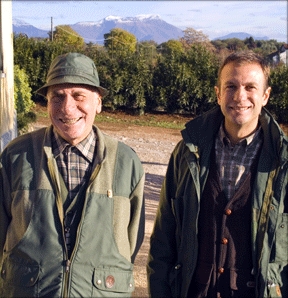
“We’re not in Kansas anymore, Toto!” I said to Steve Lamboy as we left the small home that serves as the clubhouse for the Arzaga Drugulo hunting club. Steve and I were guests of Paolo Zoli and his father, Giuseppe Zoli, owners of the preeminent gunmaker Antonio Zoli located in the center of Italy’s historic arms producing region, Gardone Val Trompia.
Arzaga Drugulo is owned by Roberto Ferrata, a charming, elegant man who inherited the property from his father several decades ago. The hunting club was named after the twelfth- century estate that included the Drugulo Castle and is presently owned by Baron Della Quara.
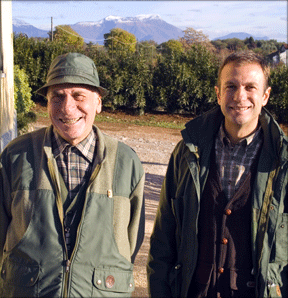
To the northwest, behind the clubhouse, was the soul-stirring panorama view of Lake Garda, the largest lake in Europe. Ahead of me, to the east, half a mile up the road on the path we would soon travel to hunt, were vineyards of syrah, merlot and cabernet franc grapes and scattered small groves of olive trees.
Lake Garda is in northern Italy between Venice and Milan and is part of the Lombardy region on the west and the Veneto region on the east. The northern tip is in the Trentino-Alto Adige region. The Dolomite Mountains can be seen towering above the lake. Many years ago and many pounds lighter, I participated in two cross-country ski marathons in the Dolomites.
The lake region offers an array of summer and winter sports activities and boasts a diverse landscape with beaches along the southern shores and rocky cliffs above the northern shoreline. One of the more elegant destinations is the Palazzo Arzaga Hotel Spa & Golf Resort, a beautiful 15th-century palazzo that offers luxury lodging and dining, spas and one of the finest golf resorts in Northern Italy.
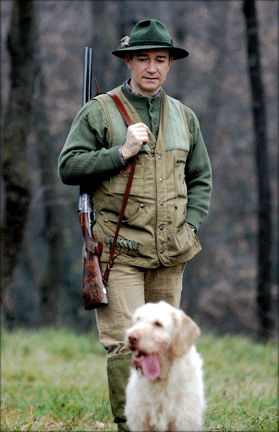
The Palazzo and similarly elegant accommodations in the area are priced at a level not for those with high blood pressure, as they toddle around in the range of $2,000 per night.
Forests and Fields
Typical for November, rain had drenched the valley much of the evening and mist still hung in the air like a shroud. We put on our hunting boots and oiled jackets and then Paolo, as a gesture of generosity, gave me his personal Super Luxus 20 bore over/under for my hunting. Steve carried a new Columbus 12-bore field configured model.
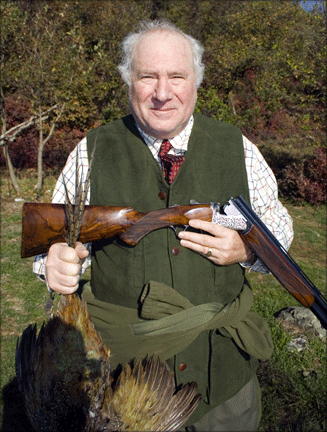
Unarguably, the crown jewel of the Zoli guns was Giuseppe’s handcrafted Holland-style 20-bore sidelock. The engraving motif was a Zoli family portrait in a hunting scene brilliantly executed by Angelo Galeazzi, by all measures ensconced in the Pantheon of Italy’s finest artists. Angelo and Giuseppe’s friendship dates back to their childhood.
Long-time Zoli family friend Angelo Gustonelli joined us. An industrialist and wine collector, Angelo possesses a sharp wit and an exuberance for the outdoors. We walked three quarters of a mile or so up the path to the section of forest where our hunting would begin.
The vineyards were now shorn of leaves and fruit, the olive grove stark and gray and a cornfield, smaller than a football field, sprouted husks and dried stalks. Nope, this wasn’t Kansas or Nebraska or Colorado or Montana or any other place I’d been fortunate enough to hunt pheasant.
Although we would hunt pheasant and partridge in a few small cornfields, those topographies were mere grace notes to the thick wooded forest in which most of our hunting would take place.
The dark forests and glens had an enchanted quality. A pungent musk smell of earth and damp wood and grass filled the nostrils. Sunlight entered in slices through the tree limbs and leaves. We traversed leaf-strewn narrow paths up and down gently rolling terrain. Under the command of Vero de Micheli, the dog handler and guide, the pair of labradors worked the brush and grass with the precision of an Olympic skating pair.
A pheasant exploded from a tree. Giuseppe pivoted with a grace that belied his 80 years and brought the bird down with one well-placed shot. Tails wagging like an old-style musician’s metronome, the dogs promptly retrieved the bird and placed it at Vero’s feet. Very few shots are had on this type of hunt. Each is precious. Each has meaning.
We hunted leisurely in the forest for perhaps an hour and a half. Paolo pointed out many tiny bird houses attached to trees. Small birds of a certain species are raised as a food delicacy, and are eaten whole, bones and all.
We exited the forest and approached a cornfield. The dogs ran through the tall, wet corn stalks, causing water to spray in their wake as if from a slalom skier. A bird shot up and Steve fired. Moments later it was retrieved and presented to Vero. The dogs now energized and active, I walked cautiously and prepared for a shot, flipping my gun’s safety on and off like a Cuisinart switch when making brioche dough.
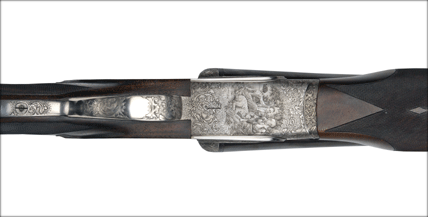
I stopped a moment to absorb the beauty of the area. The elevation of the field offered an unimpeded view of the southeast end of Lake Garda. Its elegance was exquisite and soothing, the air still and fragrant. Pleasure boats, hydrofoils and catamarans dotted the water. Car ferries traveled between small towns on opposing coasts, such as between Toscolano Maderno and Torri del Banaco.
Memories were rekindled. I hadn’t visited Lake Garda in several years. My first visit was in March, 1997 when, with the assistance of engraver Mauro Dassa of Incisioni Dassa, I toured the factories of several elite gunmakers. My most recent visit was in 2005, while I was working on an article for Beretta.
During that trip I and Mauro and his family had dined at a lakeside pizzeria, enjoying a sumptuous dinner of delicately fried calamari and pizzas with the thinnest crust covered with basil, fresh mozzarella cheese and smoked salmon, accompanied by several bottles of delicious local sparkling and still wines.
Colorado and Italy have, I think, the most gorgeous skies, and now shards of sunlight were hacking through gray slabs of clouds like hatchets. Light glinted off the perfectly blued barrels of the Luxus and the exhibition grade wood seemed possessed of an inner glow. The observations about the gun had greater significance because the day before I had been in the factory and seen them produced.
I watched the steel milled to one-ten thousandths of an inch tolerance and I drooled at the magnificent stock blanks stored in humidity-controlled vaults as if they were the finest Bordeaux bottles.
Steven, Paolo and I walked on a dirt path, cornfield to our left, deep growth forest to our right. Angelo yelled. We pivoted to our right. I saw a flash of color disappear into the trees. It was a woodcock, the queen of the wood and a rare sighting.
Paolo and I were talking when Vero yelled again. A magnificent pheasant had flushed and flew directly at us, an easy shot, but we were unprepared. We shrugged simultaneously and continued our discussion on the merits of using olive oil when cooking sea bass.
We continued hunting at the forest’s edge. The dogs began yelping furiously. Paolo and Steve were a few yards behind me; Giuseppe further back and in the woods with Angelo a step behind him. A pheasant flushed from brush within the woods and took off like a missile toward the top of the trees at the edge of the woods. The window of visibility was minimal. I twisted to my left while simultaneously shouldering the wand-like 20 bore and fired.
Paolo cheered, “Elegante, Michael!” A perfect shot! I was pleased. My colleague, Steve Comus, editor of Safari Magazine, once told me, “When you make a perfect shot with a beautiful gun, all is right with the world.” Even if all is right for just a moment, I’ll take it.
Time for Lunch
We returned from the hunt to the clubhouse in soaring spirits. Each of us had been successful with at least one challenging shot; the weather had warmed the earth and burned off the moisture and Garda glistened in the distance like a patch of diamond dust.
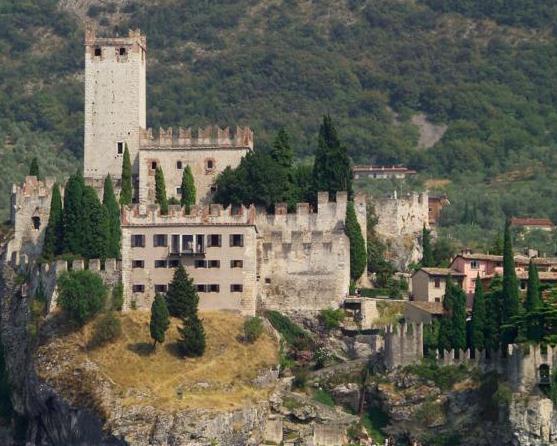
History drenched the clubhouse. It was old; it smelled old and it had that exquisite quality indicating that uncountable marvelous hours had been enjoyed within its confines. Photographs of club dignitaries covered the walls, including several of the Beretta and Zoli families dating back two-thirds of a century. A well-used wooden gun rack, scarred from butts and barrels, was attached to a wall near the window, the temporary residence for our cleaned and oiled guns.
Teresa, our chef, introduced herself as she presented the first course of our lunch. Teresa is a beautiful woman with an alluring smile that made me feel as if I’d been part of her family for decades. We were directed to dip her fresh-baked warm bread into dishes of olive oil, a first pressed creation named mosto, made with olives from her own groves in nearby Garda.
The oil was green and fresh with a fragrance more seductive than the finest Parisian perfumeries. To tell you the truth, it was the most delicious olive oil I’d ever tasted. I was inclined to drink it directly from the bottle.
I was instructed not to shake the bottle of the creamy unfiltered oil. I figured having the sediment that lay at the bottom of the bottle mixed with the oil would enhance its flavor, but those who purported to know better dissuaded me.
The lunch was in the style tipica Bresciana, that is, typical of the Brescian region. We began with an antipasto selection of sausage, salami, loaves of bread, marinated onions with finely grated parmesan cheese and fresh aromatic unpasteurized gorgonzola cheese that oozed honey-like with ripeness and tangy flavor.
The next course included meat-stuffed ravioli with truffles soaked in truffle oil that were absolutely ethereal, accompanied by warm polenta with mushrooms. Usually made from corn, as was ours, polenta is also made from buckwheat or chestnut flour and is a traditional accompaniment with meat dishes.
The main dish was a traditional beef presentation, prepared by gently poaching the beef in water for three hours or so, then pouring on it a sauce made with olive oil, capers, garlic, anchovies and parmesan cheese. The word “fabulous” fails to do justice to the preparation.
Wine graced the table, including a Marsadri Gropello Garda Classico, a red wine made from the same kinds of grapes grown in the vineyards I saw on the property – primarily cabernet franc and syrah.
All the wines were made locally in the Franciacorta region in Lombardy, producer of its finest wines. It is a small geographic area to the southwest and is favored by a unique micro climate influenced by the cool consistent temperatures due to the two large lakes, Garda and Iseo.
Terre di Franciacorta DOC applies to a sturdy red from Cabernet, Barbera and Nebbiolo grapes, as well as to white wines from Pinot Bianco and Chardonnay grapes. Only wines from select vineyards in the zone qualify as Franciacorta DOCG, the highest rated appellation. According to Italian wine law, Franciacorta wine must be aged for at least 18 months and vintage Franciacorta wine for 30 months. Although not of the Piedmont and Tuscan level of elegance, Franciacorta produces quite respectable still wines at fair prices.
Franciacorta’s reputation has been built on the outstanding bottle-fermented sparkling wines fashioned by select estates. They are constructed by the same method utilized in France’s Champagne region. The wine is fermented in the bottles, rather than in a vat. This leads to smaller, more plentiful bubbles and a more subtle taste. Lo Sparviere, Beretta’s vineyard, for example, produces a sparkling rosè that I rate as outstanding. Nearly one-third of Italy’s bottle-fermented sparkling wine is produced in Franciacorta.
As our luncheon drew to a close, and as if we had not already red-lined our gustatory capacities, the meal ended with a selection of grappas, made as a byproduct of wine where the alcohol content is substantially elevated. Grappa is not to my liking, in that I find its fragrance similar to that of gasoline and tastes about the same, based on an accidental ingestion of the latter when filling my lawnmower. Prudently I devoted my last caloric ingestion to the wonderful wines and to the memorable gorgonzola.
History of Arzaga Drugulo
My education on the history of Arzaga Drugulo had begun the prior evening. Me and Paolo attended a jewelry exhibition presented by Roberto Ferrata and his beautiful and effervescent wife, Nicoletta, at a gallery in Bresica.
The exhibit featured the stunning work of internationally acclaimed artist David Webb. Many of the displayed pieces, I was told, were from Elizabeth Taylor’s expansive collection of Mr. Webb’s works. Gold and silver necklaces and bracelets encrusted with diamonds and rare gemstones abounded.
The modern Arzaga Drugulo hunting club was founded in 1926 from land belonging to the Della Quara family. Presently there are about forty members. In the 1950’s, Carlo Beretta was an owner with Roberto’s father and hunted there often with his father and with Giuseppe Zoli.
The hunting preserve is located in the village Soiano del Lago in the province of Brescia. The territory extends to the edge of Lake Garda. The terrain is predominantly hilly and the vegetation is comprised primarily of natural woods and some agriculture acreage used mostly for corn and wheat production. Vineyards and groves of olive trees constitute part of the property.
The first concession released for the Reserve of Hunting Arzaga Drugolo is dated 1786, assigned by the Venetian Republic to the Count Averoldi, then owner of the estate. The concession was valid for only a few years and was revoked with the arrival of Napoleon at the beginning of the 1800’s.
In 1926 the Count Averoldi (a descendant of the earlier count) received from the King of Italy again the hunting concession on this estate. The concession was held for ten years when in 1936 he passed it to Mario Ferrata, Roberto’s father.
The Ferrata family had been owners of one of Italy’s three most prestigious arms factories, Domenico Sabatti, from 1850 to the early 1900’s, when they sold the firm to Beretta. Hunting has always been a passion for the Ferrata family and, it was thus logical that Mario enlarged the estate and improved the terrain to make it more hospitable for game birds.
After Mario’s death in 1987, Roberto took over the company and the property and is the current manager. The estate extends for around 800 hectares (about 2,000 acres) and is divided in three zones of hunting of around 250 hectares each. It is possible to hunt hare, pheasant and red legged partridge. Hunting groups using rifles are generally limited to four people in each hunting zone.
The preserve offers driven shooting on special occasions, where groups are limited to six to eight hunters. Typically the drive will extend two to three days with three to six hundred pheasant and partridge available.
During its 80 years Italy’s most prestigious names in the gun trade such as Beretta, Bosis, Zoli and Pedersoli as well as nobility and diplomats have hunted as Arzaga Drugolo. Today the firm is international and entertains people from all the parts of the world.
In his parting words to me at the art gallery the night before, as we sipped a Franciacorta sparkling wine and enjoyed a slice of one of Lombardy’s marvelous cheeses, Roberto shared snippets of his philosophy about his club.
“It’s like my personal hunting club. That is, it’s like a hunting home. I can share it with friends and with people that respect hunting and its traditions.”
I asked what drives him to invest so much time and money in the club. “We are stewards for future generations. If we do not preserve what is beautiful, then who will?”
Arzaga Drugulo and Italy’s hunting tradition are in good hands.
Additional information:
Zoli
http://www.zoli.it/index_usa.php
Arzaga Drugulo: www.arzagadrugolo.it
Where to stay:
Albergo Trattoria Marcheno
http://www.hotelmarcheno.it/uk/hotel.htm

Michael Sabbeth is a lawyer in Denver, Colorado. He lectures on ethics and rhetoric to law associations and civic and business groups. He is the author of the The Good, The Bad & The Difference: How to Talk with Children About Values. Please visit his website at www.kidsethicsbook.com.


Comments